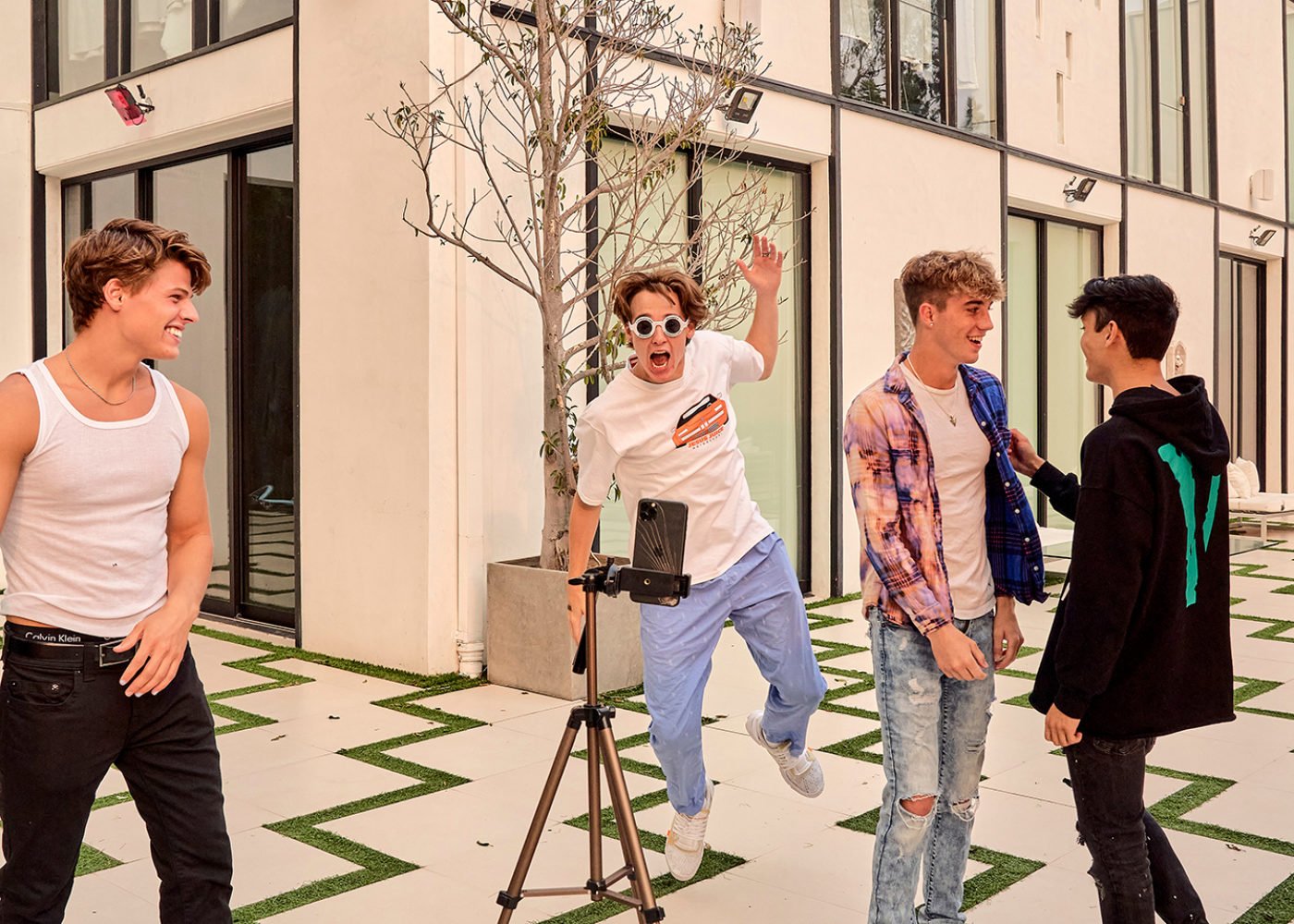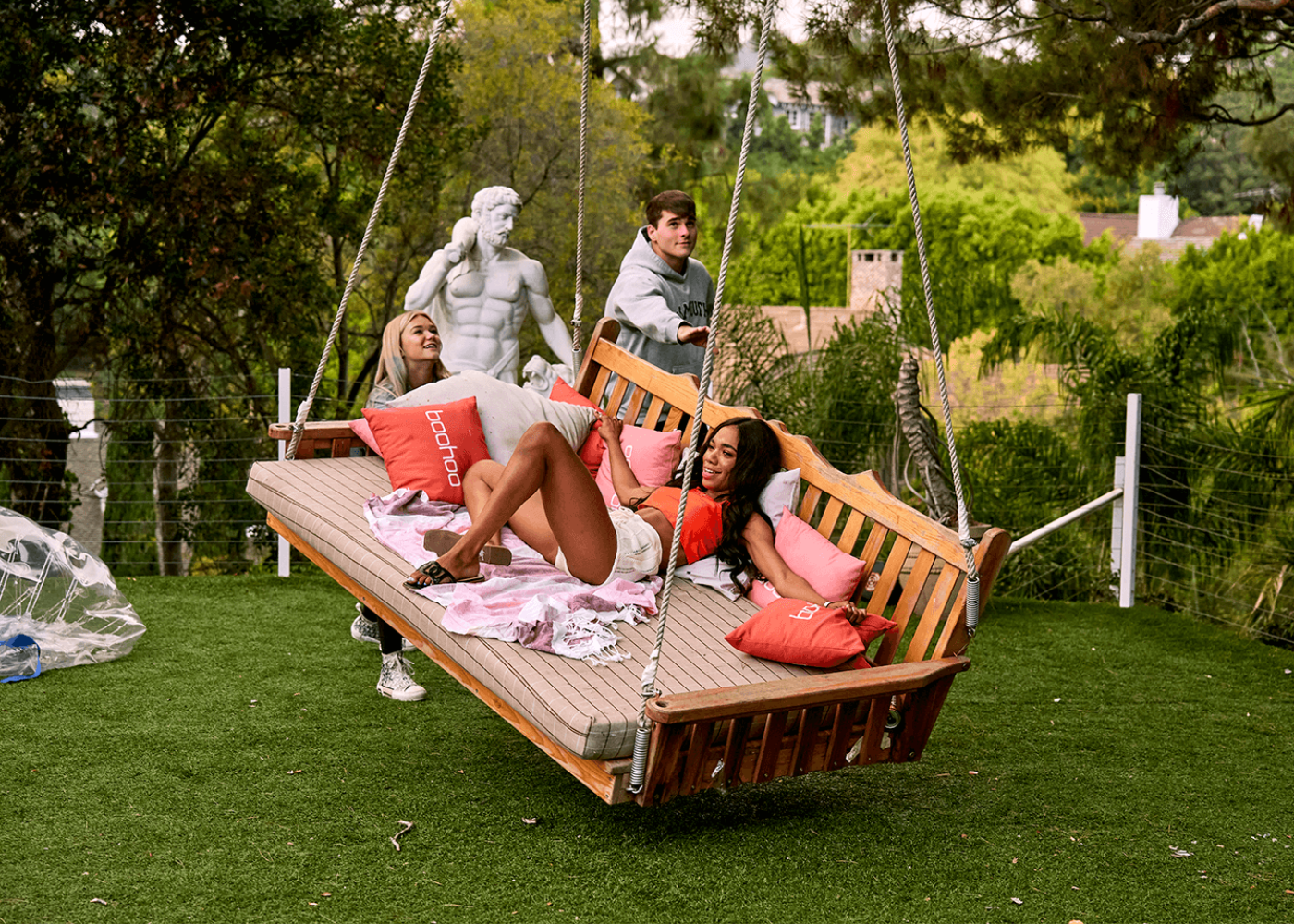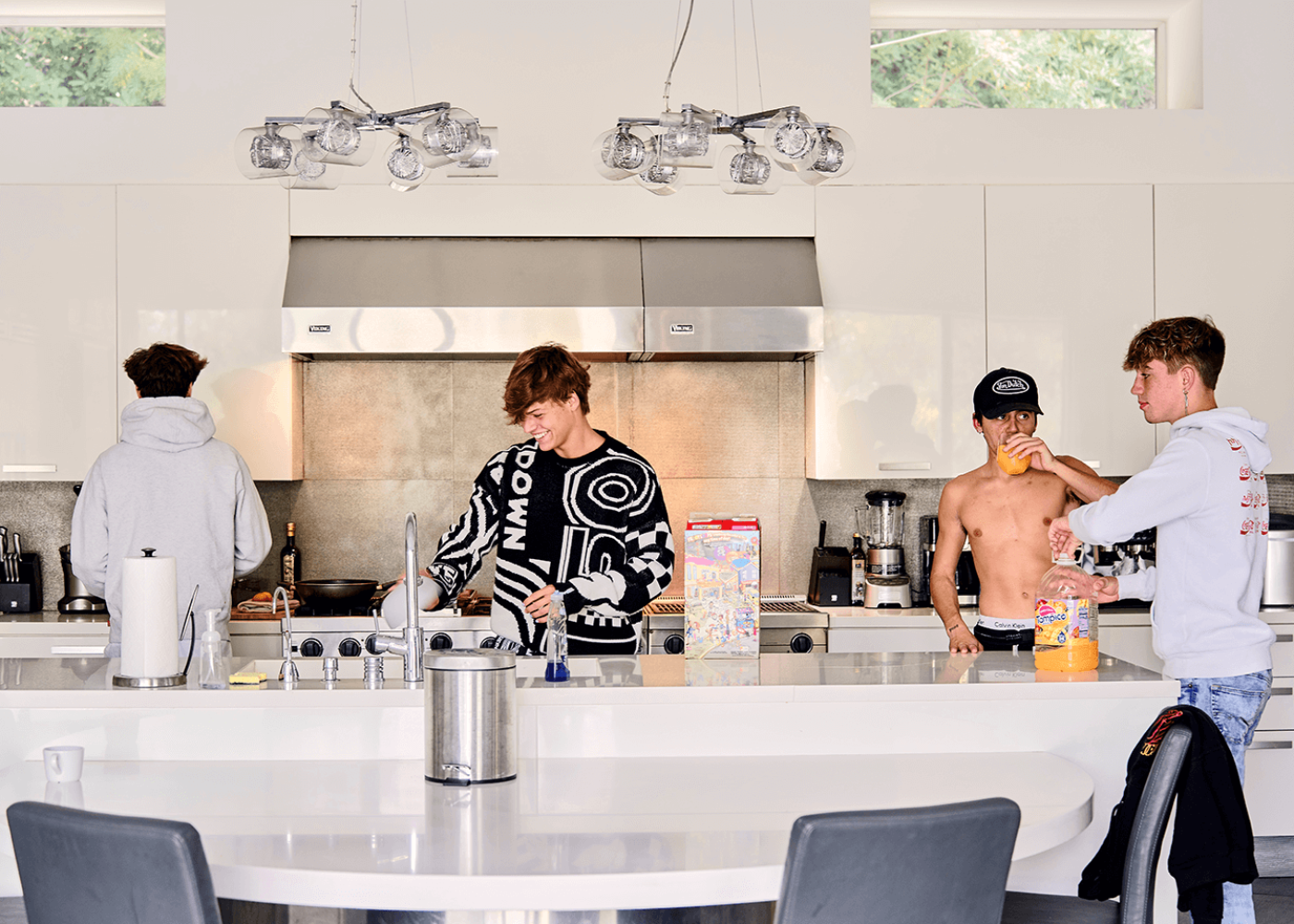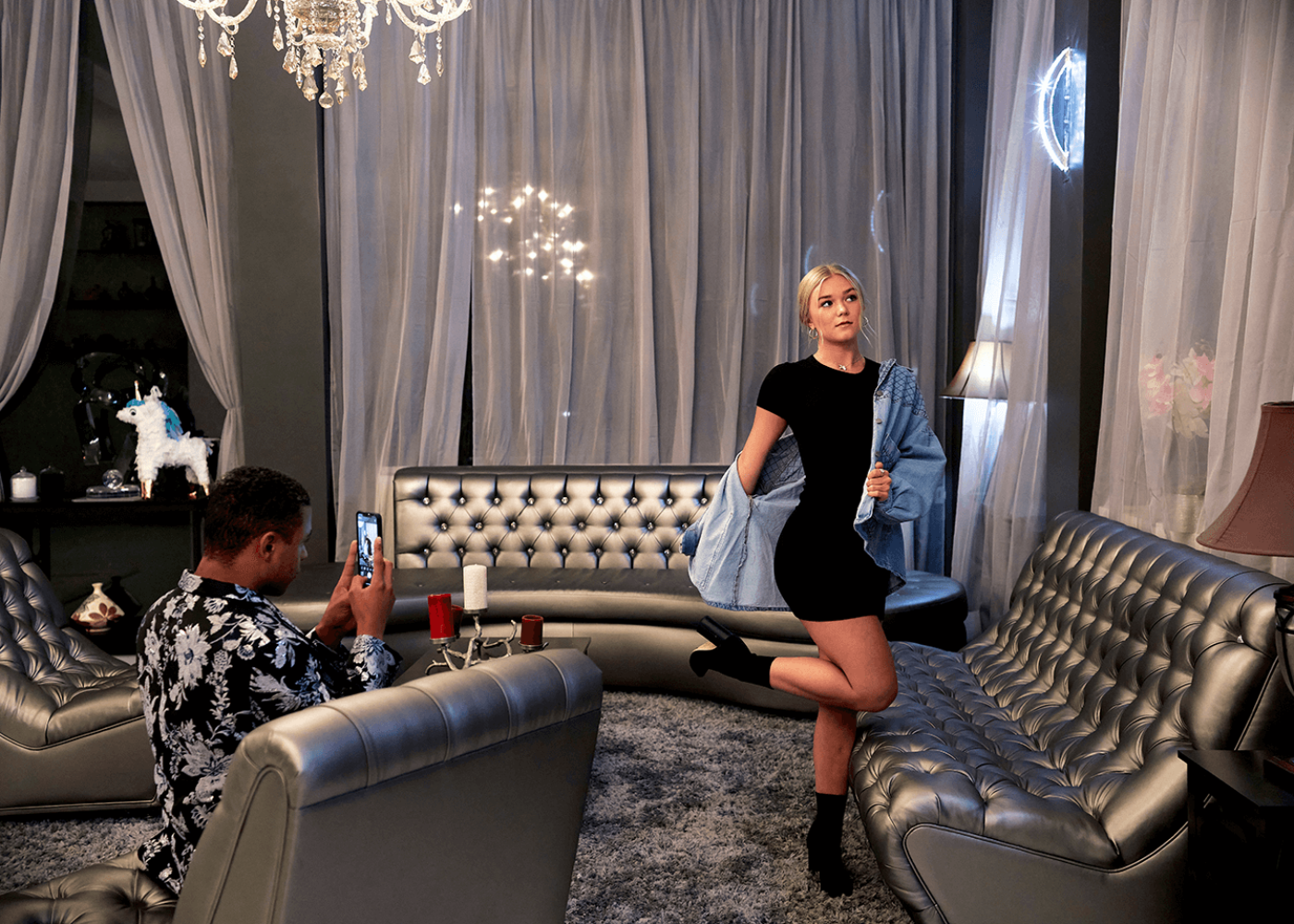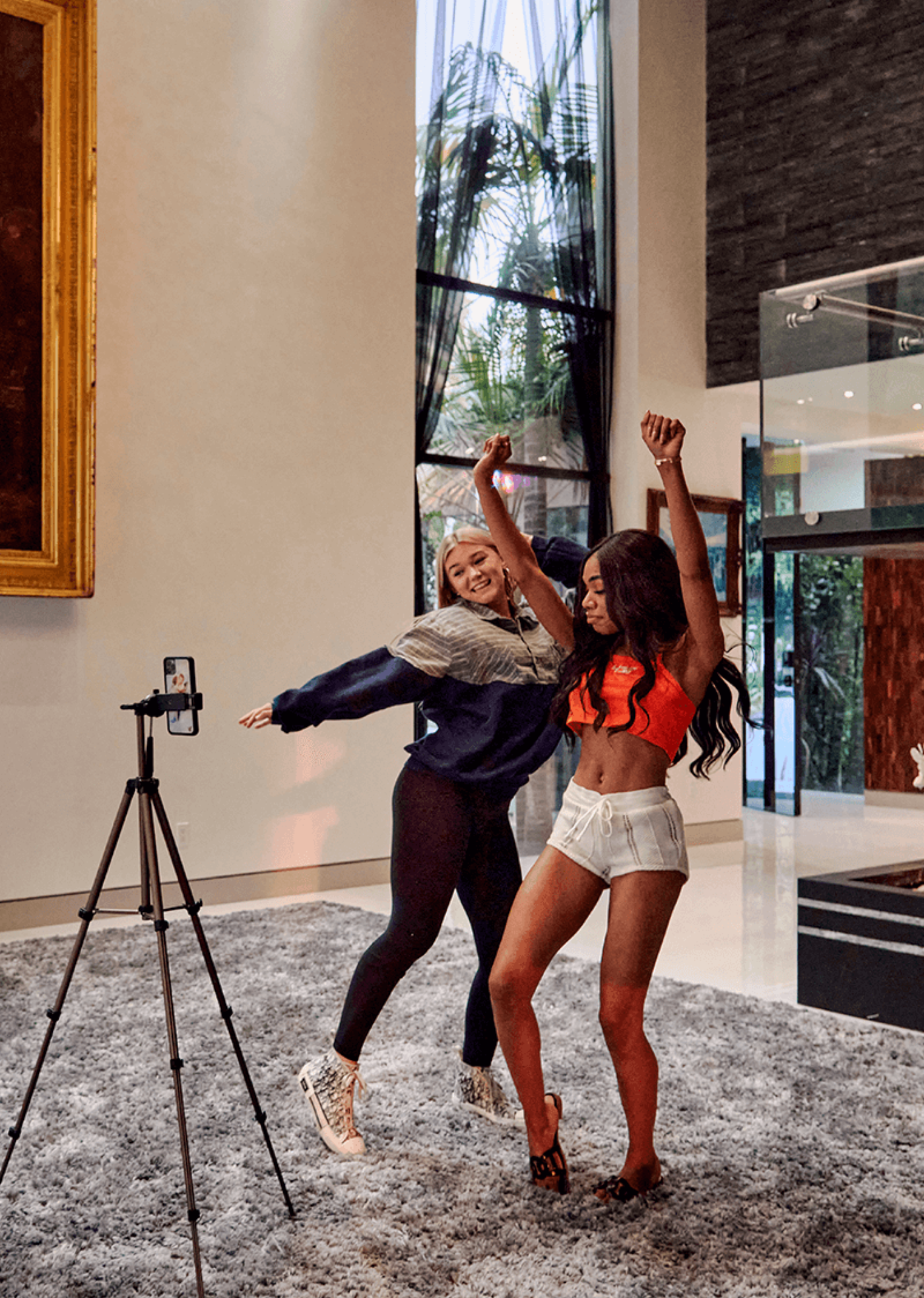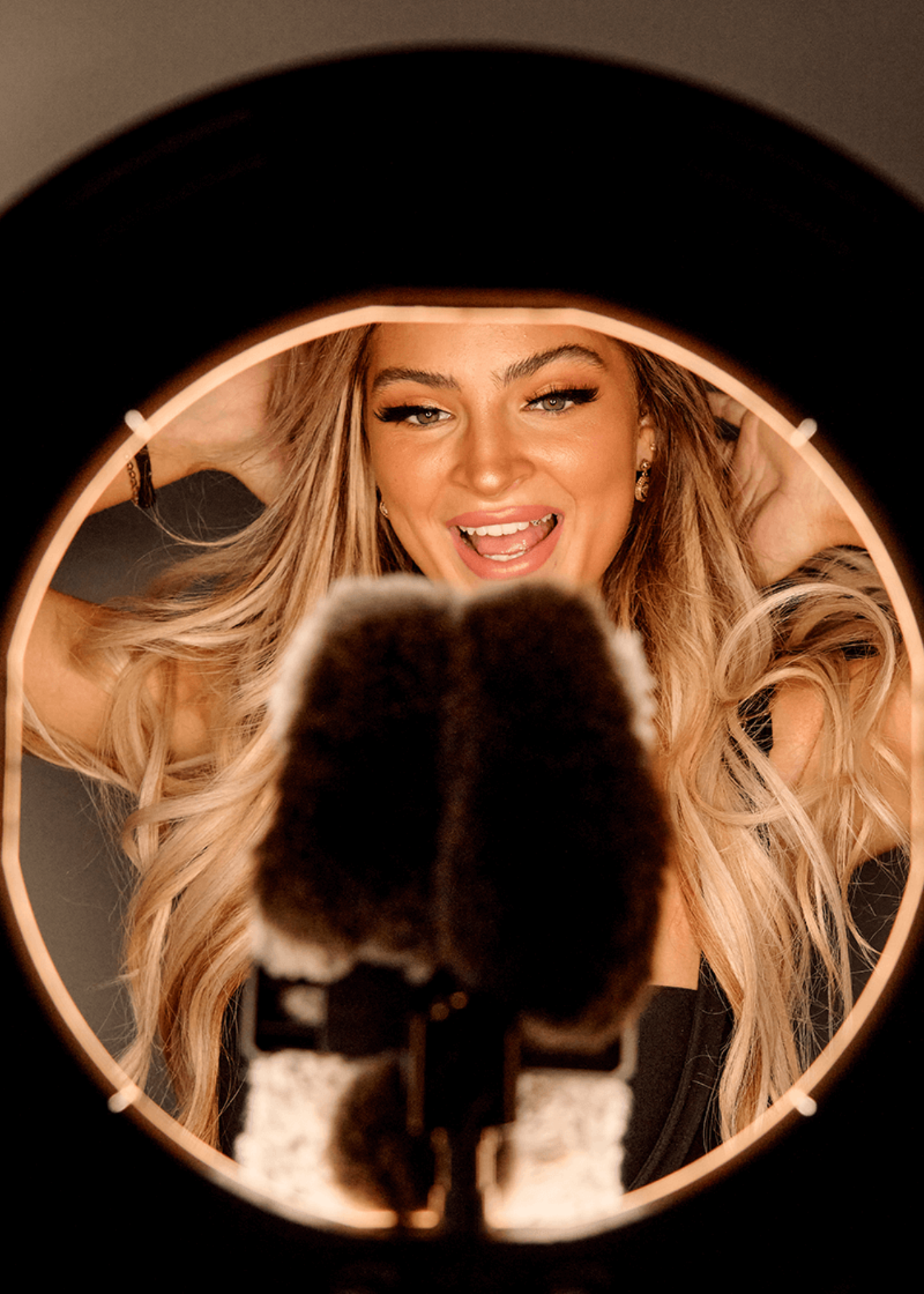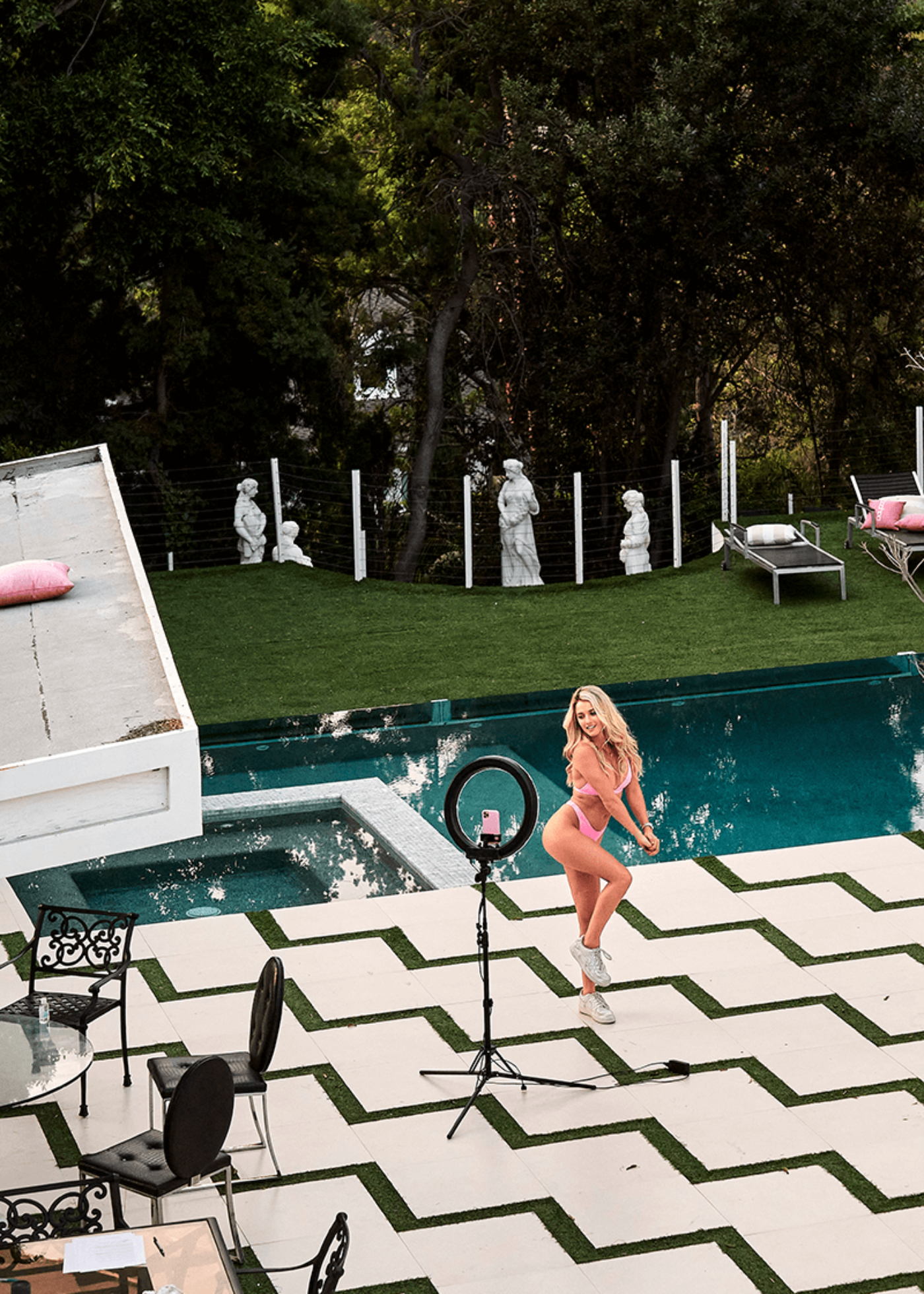The Anxiety of Influencers
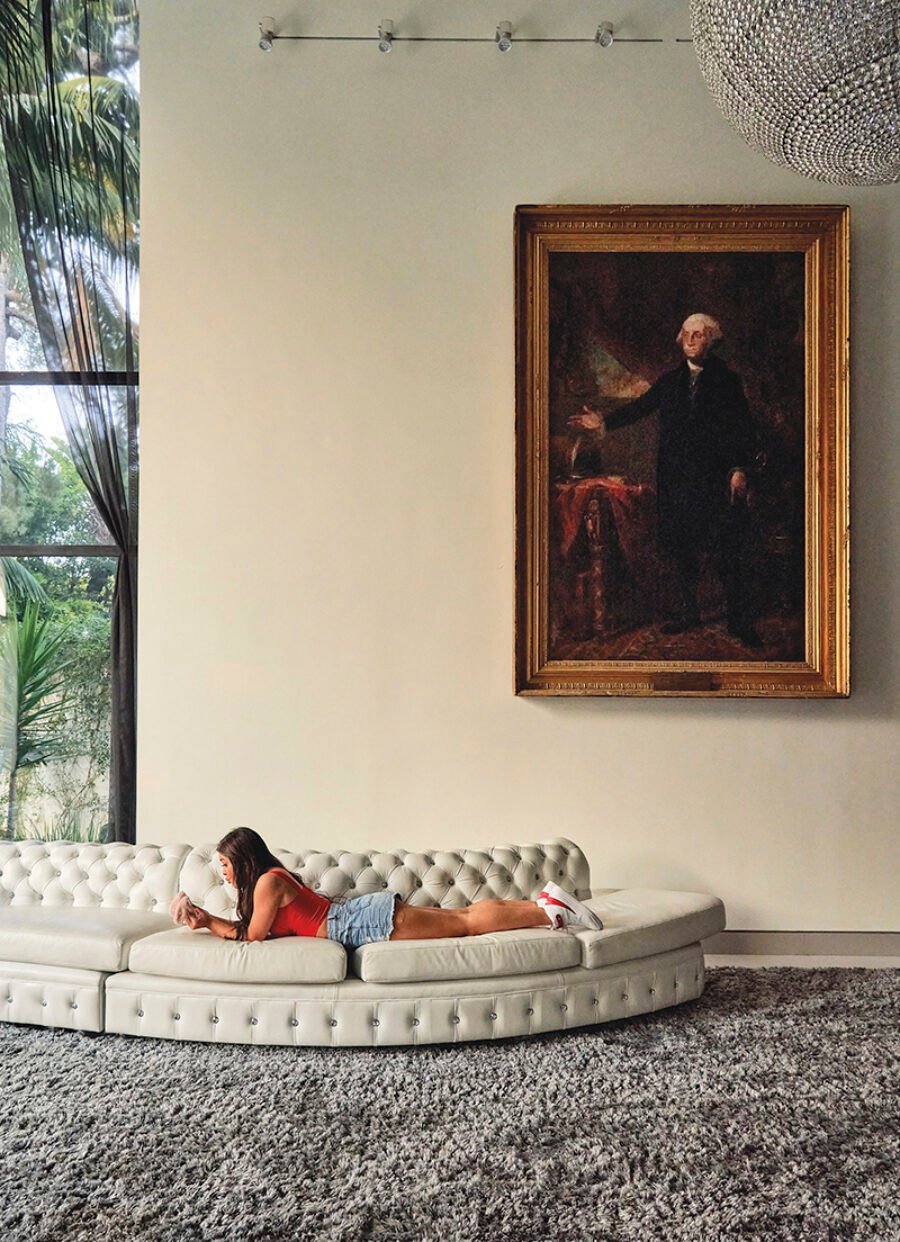
Influencers at Clubhouse Beverly Hills, Clubhouse For the Boys, and Not a Content House, in Los Angeles. All photographs by Philip Cheung, September 2020, for Harper’s Magazine © The artist
It’s noon in Los Angeles toward the end of the Plague Year, and I’m lounging on the patio of a swanky three-floor mansion, watching a scrum of teenage boys perform trending TikTok dances. Arranged in a tidy delta formation near the jacuzzi and pool, the five boys smile into the glare of a ring light, at the center of which is affixed a smartphone recording their moves. These boys possess a teenybopper cuteness and, because they’re between the ages of eighteen and twenty, they have noisomely strong metabolisms and thus go shirtless pretty much all of the time, displaying either the ectomorphic thinness of trees or greyhounds or, in one boy’s case especially, the sharply delineated musculature of a really big insect. They bite their lower lips, and their expressions are—I’m sorry, there’s no other way to describe them—precoital.
Dances that go viral on TikTok, the video-sharing service that has become the most popular app on the planet, tend to be easily replicable, so the choreography is pretty simple and—no offense to the boys here but—kind of cheesy and lame. It’s as if the entire art form were based off the hand jive or the Macarena. For example, when the vocalist sings “throat bay-bee!” each boy makes a cradle with his hands, as though shushing a recalcitrant infant. And then during the next lyric—“I’m tryna bust all on ya”—each turns to the side and humps the air with the gracelessness of a jackrabbit. Wearing a motley assemblage of billowing hoodies and prestige sneakers, these boys are residents of something called Clubhouse FTB—or Clubhouse For the Boys—one of the most popular collab houses that have sprouted up in Los Angeles.
Also known as content houses or TikTok mansions, collab houses are grotesquely lavish abodes where teens and early twentysomethings live and work together, trying to achieve viral fame on a variety of media platforms. Sometime last spring, when most of us were making bread or watching videos of singing Italians, the houses began to proliferate in impressive if not mind-boggling numbers, to the point where it became difficult for a casual observer even to keep track of them. There was Hype House and Drip House and a house called Girls in the Valley. There was FaZe House (for gamers) and Alt Haus (for outcasts) and one called Byte House, the first of its kind in the U.K. Perhaps the most recognizable was the Sway House, tenanted by a cohort of shaggy-haired bros whose content consisted mostly of lifting weights and pretending to have sex with their smartphone cameras. Essentially, they were the Brat Pack of Gen Z, replete with bad-boy antics and dangling, cross-bearing earrings.
For the past twenty-four hours, I’ve been dwelling among the influencers at Clubhouse FTB, enduring bouts of dick jokes and long glugs of White Claw, the sort of chaffing male camaraderie you’re apt to find in frat houses or hunting lodges. Among the various House Rules, which are enumerated on a whiteboard in the dining room of this mansion, are boldfaced injunctions to wake up by 10 am, to refrain from drinking Sunday through Thursday, to hold house meetings every morning at 11:30, and to “finish brand deliverables before inviting guests.” Unlike some other houses, the Clubhouse isn’t owned and operated by the influencers themselves but is overseen by outside investors. In exchange for posting three to five videos per week to the Clubhouse social-media accounts, the boys receive free room and board, plus whatever brand deals they can get based upon their “relevance.”
“When coronavirus hit,” Baron Scho tells me during a break in the action, “I was like, all right, I’m gonna get TikTok famous.” Baron was living in Galveston, Texas, and studying something called “maritime business”—think: port shipping; think: barges—when he started posting videos of himself four or five times a day. Despite the drab backdrop of his performances—a dimly lit bathroom with a popcorn ceiling—his grooves were both riveting and infectious, earning him plaudits from several TikTok stalwarts. Then he did a dance to Travis Scott’s “Out West,” and things got nutty after that. Now he’s nearing a million followers, and he figures that with impending brand deals, he could maybe start bringing in “like seven thousand dollars a week.”
Christopher Romero, an angel-faced nineteen-year-old, tells me that he “literally came from nowhere,” by which he means Greeley, Colorado. One day after school, bored by his video games and feeling a little lonely, he decided to hop on an app called YouNow, a broadcasting service where users could stream live content. “I would just talk about my day, and I only had maybe like five viewers. I remember for a hot minute it was just like a steady five.” Within weeks, he had a devoted fan base of some twenty thousand viewers. “Bro, when I was asleep,” he says, “I’m not even kidding, I would have like two thousand viewers just like watching me sleep.” His burgeoning fame didn’t quite click for him, though, until one day when he and his mom were at Walmart, and somewhere between the generic-brand T-shirts and the economy-size packages of Bounty and Rolaids, a group of shrieking girls accosted him and just about demanded that he take selfies. Understandably, his mother was flummoxed. “She’s like, ‘Why are these girls freaking out? Why do they want to take pictures with you? What is happening?’ And I finally just told her, ‘I’ve been livestreaming on this app.’ ”
Now, on the pool deck, the boys tussle and roughhouse with the zeal of Labrador puppies, slugging each other lovingly in the shoulders and then retreating with giggles like ninnies. As one boy gets chased, he shrieks, “Yo, bro, bro! I was just kidding!” They’re so caught up in their own antics that they hardly even notice my presence. In this way, I can float among them like a ghost in a Henry James novel, loitering on the edge of the patio as they arrange a post for Instagram. In some sense, they are like college boys anywhere, except that they live in a seven-thousand-square-foot mansion, a residence whose value is roughly $8 million and whose rent is $35,000 a month—which, it must be said, is more than half of what I make in a year as a tenure-track university professor.
The pool deck looks out on the undulant topography of Beverly Hills, with the steeple tops of pine trees etched in the distance. All this would seem idyllic if it weren’t for the noxious blots of smoke from the wildfires that have been enshrouding California, which lend the sky a kind of disaster-movie ominousness. The West Coast is on fire. Fifty thousand Americans are contracting COVID every day, and the economy is drawing ever closer to a very steep precipice. Against this apocalyptic backdrop, it’s been strange to watch these kids gambol and twirl, since it reminds you of nothing so much as Nero and his fiddle. When I ask the boys whether they’re concerned about the state of the Republic, they rub their noses and look up from their phones. “What? Nah, man,” one says. “Things are getting better every single year.”
According to a poll released in 2019, some 54 percent of Americans between the ages of thirteen and thirty-eight would, if given the chance, become a social-media influencer. A whopping 12 percent believed that this term already fit them.1 Once the purview of heiresses like Paris Hilton and Kim Kardashian, it seems that influencing has become fully democratized, making a Jay Gatsby out of every intrepid Jimmy Gatz. Or as one collab-house press liaison puts it to me: “It’s the new A-list celebrity except it’s attainable for anybody. You can be in Cleveland, Ohio, alone in your bedroom, and you can get a million followers overnight. That’s fucking crazy. That’s never been possible. Wealth, fame, status has never been more attainable for anyone in the history of the world the way it is right now.”
Amir Ben-Yohanan, the CEO of the Clubhouse venture and a real-estate mogul from New Jersey, describes the state of the collab-house industry this way: “It almost reminds me of the old days in the U.S. when people got on their horses and buggies and went west for the Gold Rush. And everything was uncharted territory, and they got to California and Colorado and they marked their territories and said, ‘This is mine.’ And they started digging, and some of them made a lot of money and some of them didn’t succeed, and it was totally unregulated . . . and what dawned on me was that the social-media market is a lot like the Wild West. There are a lot of kids running around. And there aren’t any patterns to the behavior. A lot of people are just dropping out of college and moving here literally with a bag and the hopes of becoming an influencer.”
Whereas the average college grad rakes in $50,000 a year, an influencer with more than a million followers could net that much in a month. And at a moment when virtually every other industry is shrinking if not flatlining, the influencer marketing industry is projected to be worth $15 billion by 2022 and currently accounts for roughly 15 percent of the total global ad spend. Indeed, it seems the influencer economy has infiltrated every last sector of the market, with Hollywood casting Instagrammers for their massive online followings and pop stars seeking out TikTokers in the hope of achieving virality. From a certain vantage, then, these influencers aren’t so much celebrities as they are prototypes of laborers in the new passion economy, a glittering premonition of where the world seems to be heading. If the collab house owners are doing more than profiting off these youngsters—Clubhouse takes as much as 20 percent of their earnings—perhaps they are also tutoring these young people in the rigors of this system, preparing them for the psychic demands that this new world would ask of them. “We really see ourselves as an influencer university,” Christian Young, one of the Clubhouse co-owners, tells me.
As bizarre as it might seem to compare a collab house to a university, the metaphor gets repeated enough times throughout the weekend to make me wonder whether it’s codified somewhere in the venture’s mission statement or in the annals of its corporate propaganda. Later in my visit, Chase Zwernemann, the twenty-one-year-old VP of talent management, will tell me that “we really see ourselves like influencing professors.” And if this weren’t enough, under the Clubhouse aegis is a trio of TikTok houses, each of which corresponds, apparently, to a different level of academe. There’s Clubhouse BH—the grad school—which is meant for “our more seasoned influencers.” (If this phrase conjures for you images of geriatrics taking selfies in suggestive postures, please know that by “seasoned influencers” they simply mean people who have been in the business a while and have thus reached the ripe old age of twenty-two or twenty-three.) Beneath that is Clubhouse FTB, which apparently serves as the undergraduate program. And finally, there’s Not a Content House, the high school of the Clubhouse venture, one meant to appeal to an even younger demographic.
If the repeated deployment of this metaphor makes me wince, it is perhaps owing to my job as a university professor, a vocation that I’ve considered to be in opposition to these forces. For the past thirteen years, I’ve taught a course called Living in the Digital Age, which mobilizes the techniques of the humanities—critical thinking, moral contemplation, and information literacy—to interrogate the version of personhood that is being propagated by these social networks. Occasionally, there have been flashes of student insight that rivaled moments from Dead Poets Society—one time a student exclaimed, “Wait, so on social media, it’s almost like I’m the product”—but it increasingly feels like a Sisyphean task, given that I have them for three hours a week and the rest of the time they are marinating in the jacuzzi of personalized algorithms.
 Dispel your main-character syndrome with a subscription to Harper’s for only $1.99 a month.
Dispel your main-character syndrome with a subscription to Harper’s for only $1.99 a month.
As someone who suffers from Churchillian spells of depression, it was easy for me to connect this to the pervasive disquiet on campus. In the past ten years, my email correspondence has been increasingly given over to calming down students who are hyperventilating with anxiety—about grades, about their potential marketability, about their Instagram followings. The previous semester, for instance, during a class on creative non-fiction, twenty-four of my twenty-six students wrote about self-harm or suicidal ideation. Several of them had been hospitalized for anxiety or depression, and my office hours were now less occasions to discuss course concepts—James Baldwin’s narrative persona, say, or Joan Didion’s use of imagery—than they were de facto counseling sessions. Even students who seemed happy and neurologically stable—Abercrombie-clad, toting a pencil case and immaculate planner—nevertheless displayed unsettling in-class behavior: snacking incessantly during lectures, showing Victorian levels of repression. The number of emotional-support service animals had skyrocketed on campus. It seemed like every third person had a Fido in tow, and had you wandered into my lecture hall when we were still holding in-person classes, you might have assumed that my lessons were on obedience training or the virtues of dog-park etiquette. And while it seems clichéd even to mention it, the students were inexorably—compulsively—on their phones.
That my students followed the accounts of these influencers made me curious about their manner of living. And as the enrollment numbers at my university continued to worsen and two of my former students emailed to say that they were dropping out of college and moving to L.A., I spent much of last summer cold-calling publicists, wanting to see where the nation’s young people were heading. I swiftly discovered that the influencer industry had become a piñata for COVID-related outrage, with a number of New York Times stories characterizing these creators as incorrigible Dionysians. The Clubhouse in particular had become a repeated target. Several of their neighbors in Beverly Hills had filed a report with the local police department claiming that, despite quarantine, Clubhouse BH had hosted a party of “over a hundred” people, with cars blocking both sides of the street and even parking in several neighbors’ driveways.
All of this led me to reasonably expect that publicists would be wary of press inquiries—let alone the kind of immersive, fly-on-the-wall piece I was proposing. So I was somewhat surprised to find, one morning in August, an email from the Clubhouse at the top of my inbox. For reasons I cannot explain, their publicists were strangely receptive to this idea. They wanted to know how long I’d stay and when I could come out. They seemed to be under the impression that I wanted to learn how to become an influencer myself. The kids would be more than happy to help me make an account, they said. “Plus, if you get three influencers to tag you in a post,” they said, “you could have half a million followers by the end of the week.”
When I return to Clubhouse For the Boys the next morning, the guys are slumped at the kitchen table, slurping groggily at their just-cooked Cup of Noodles. Apparently, last night they went to Saddle Ranch—a chophouse on Sunset that has become a hot spot for influencers—where they had a mighty piss-up and are thus now epically hungover. “Barrett,” Baron says, “last night was comedy. These four random girls were here at like two-thirty in the morning, and the next thing you know they’re topless in our hot tub, four girls that we’ve never seen before.” At this point, Baron looks at Chase, the media liaison, and asks, “Can we tell him shit like this? Is that how it works?” When I look over at Chase, he’s holding an espresso cup and saucer, and he stares back at Baron with such withering froideur that he resembles one of those Dust Bowl farmers in a Dorothea Lange portrait.
Beyond whatever else I might think about Baron’s statement here, what’s revealing to me is how poorly these guys were prepared to interact with a journalist. Despite Christian Young’s claim that the Clubhouse is an “influencer university,” it’s clear within minutes of my arrival that the guys don’t know what they should say on or off the record, or that they can decline to comment if they’re uncomfortable with a question. It occurs to me that the Clubhouse management actually cares very little about the long-term fates of these kids. After all, there’s a fungible supply of well-complected youngsters constantly streaming into Los Angeles. Only a very small percentage of these kids will actually make it in the industry; the rest of them, Amir tells me, will eventually just “cycle through.”
The precarity of their situation prompts me to ask the boys the following unkind question: Are they wary at all about deferring college? “Fuck college!” Christopher says. “College can wait. I can always go when I’m like thirty, so I’m just gonna ride this out. Ride this wave. See where this house takes me.” Baron agrees. “I don’t know if I’ll finish college. I might, but if I don’t and this is working out, then everybody else can just suck me.” I found that the anticollegiate mood was rife among the influencers. One of the Clubhouse’s founding members, Daisy Keech, relinquished a soccer scholarship at the University of California, Davis, to chase stardom in Los Angeles. And here at FTB, DaeDae Wilson and Sam Dezz are also eschewing university despite the fact that both were offered spots on sports teams at top-flight academic institutions—basketball at USC for DaeDae and soccer at Auburn for Sam.
Perhaps the riskiness of this decision helps explain why the boys are so eager to assure me of their long-term creative capital. “People don’t realize that this industry is a really big commitment,” one of the influencers, Brandon Westenberg, tells me. “That you’re going to do this like every single day.” At first, I sympathize with his wilting fatigue until I remember that, well, all jobs are something you commit to doing every single day. “It’s exhausting,” he continues. “It doesn’t seem exhausting, like a little fifteen second video, but you gotta think of concepts, and there’s a lot that goes into making videos before you stand up and do it.”
Over Brandon’s shoulder, in a little dining area on the opposite side of the kitchen, the boys keep a whiteboard of their various working ideas. Among them are the following:
hoops challenge
desert video
pranks
skydive
roasts
tuxedos
bath robes
roommates control my day
hide n seek
“It’s like waking up every day and coming up with a school project,” Brandon continues. “Like you’re trying to impress your teachers. You’re trying to impress everyone who watches the video, and you want everyone to like it. You don’t want to post anything that doesn’t represent you, and if society’s standard is us—as being the Chosen Ones, as being good-looking kids or whatever, as being the new entertainment—then there’s standards to it. Everything you post has to be likable.”
There’s no clearer evidence for this than TikTok’s Creator Marketplace, where brands can shop through a catalogue of youngsters with the same breezy efficiency that they might otherwise experience when browsing for a J.Crew sweater. Listing influencers’ most pertinent statistics, the marketplace allows brands to search any number of specifications—country, topic, audience age, average views, etc. For example, if I wanted to add an influencer named Meghan McCarthy to my campaign, I’d know that she has 3.7 million followers, that her posts garner an average of 615,000 viewers, and that 58 percent of those people live in the United States and some 80 percent of them are women. Because these kids know that brands are hunting for the widest possible exposure, they have good financial incentive to comport themselves in ways that will meet that specification.
When I ask the boys to describe the amount of money they receive from brands, they use words like “absurd” and “absolutely ridiculous.” For instance, Christopher Romero just did a TikTok video for a Louisiana-based chicken franchise called Raising Cane’s,2 for which he and his girlfriend, Madi, were paid $14,000 and $60,000, respectively. The video features no stylized pyrotechnics, no rococo ballet of intricate choreography. Instead, the couple does that cutesy Lady and the Tramp–type thing, where they each start munching on one end of a chicken tender until they meet in the middle for a kiss. About this brand deal, Christopher says, “I’m obviously grateful, but it’s honestly crazy to me. Like, yo, this is a ten-second video, and you want to give me how much money? And Raising Cane’s is already a big brand by itself—everyone knows how good it is, so I’m wondering, like, why do you even need this?”
“Because you’re a walking billboard,” Gio Valencia says, chucking him on the shoulder.
“Is that right?” I ask. “Is that how you feel?”
“I feel like I’m a walking museum, bro. Like when we go to the mall and we walk in, and people are just staring at us—like, low-key, taking videos—it’s like I feel like I’m literally a walking art piece. It’s just like, Why do I feel like this? I’m just, like, a normal person shopping.”
“Do you want to be in a TikTok?” Gio asks, sometime before noon that morning. He says this with the gentle-voiced decorum of a duke asking a governess to dance. For a second I wonder whether he’ll reach for my hand. “It’s just fun,” he says. While I never would have dreamed of asking the boys to include me in their content—lest I earn that most ignominious of labels: clout chaser—I nevertheless admit that during my trip to L.A. I did entertain certain gauzy-edged daydreams about possibly busting a move in a Clubhouse video and thereupon earning praise from millions of TikTok users. But now that it’s actually happening and Gio is wrangling Baron and Christopher to help him, I am undergoing such booming levels of pulse-in-ears trepidation that I can’t help feeling like the millennial that I am.
Huddled in a quorum on the basketball court, under smoke-clotted skies that block out the daylight, the boys begin scrolling through possible audio, trying to choose a song with easily retained choreography—I get the sense that the boys don’t really rehearse their dances. Christopher pauses over a number where the TikToker in question turns to the side and, in the manner of a pugilist warding off blows to the head, raises clenched fists over his face and proceeds to thrust his hips blindly, with prurient torque and velocity.
“What about this one?” Christopher says.
“Uhh,” I say. Do the boys know anything about academic tenure? I explain that this year I’m going up for a promotion to associate professor and that I’m worried that my university’s administration, which has become Scrooge-ish, money-wise, in light of the COVID pandemic, might not take too kindly to a video of one of their professors dry-humping nothing for the entertainment of TikTok viewers. But this candid hand-wringing elicits only squealing guffaws from these kids—who are kind of delighting in the prospect of my professional demise and keep enjoining me to “just do it.” Eventually, Christopher says, “Okay, okay, what about this one?”
The song we choose is “Whole Lotta Choppas” by Sada Baby, a snippet of trending audio whose fetching bass line makes you think of drop-tops with hydraulics or roller rinks on Saturday nights. And even though these lyrics strike me as an opera of misogyny (“Ooh, lil’ bitch wanna ride it / Told the bitch, don’t get out her body”), the corresponding dance is innocuous and tame compared with the twerking and Elvis-grade hip-flicking that would have been required by the boys’ other options.
Readers of a certain vintage might well remember the seminal scene from the 1985 Tim Burton comedy Pee-wee’s Big Adventure in which the titular hero, on a quest to find his stolen bicycle, wanders into a Texas biker bar and cues up “Tequila” by the Champs. He proceeds to jump onto the bar and do a little jig where he pumps his fists twice in front of his torso and then twice behind his back. Anyways, the dance to “Whole Lotta Choppas” is essentially Pee-wee’s “Tequila” dance, which might be why I’m able to execute the choreography on our group’s first attempt and to do so with what I’d humbly suggest is Baryshnikov-ish panache. Once we’re finished, the boys hunch over the smartphone and laugh insouciantly at our antics, and just like that, the content creation is finished. “And that’s how you make a TikTok,” Christopher says.
“Yo, what should we use for the caption?” Gio asks.
Some of the boys rattle off possible options until DaeDae comes up with the winner. “What about ‘New FTB member: Barrett from Harper’s?’ ”
The other boys respond with a spontaneous festival of backslapping and self-congratulation. DaeDae keeps uttering, “You like that? That’s what I’m saying. That’s what I’m saying!” And some of the other boys are high-fiving and chest-bumping like we just won the national championship.
I use this overblown celebration to hustle to the bathroom, whereupon I engage in what’s become consummate social-media behavior: I sign on to TikTok and wait for the comments. Mere minutes have passed since Gio uploaded our vid, and already it has garnered tens of thousands of viewers. It has been liked two thousand times, which is probably more pixelated attention than I have ever received for my writing. What is this feeling? A weird admixture of exposure and veneration that makes me feel half like Jennifer Aniston and half like a Chippendales stripper. There is something a little hostile, a little sneering, about a lot of the early comments, sort of in the same rhetorical vein as “Dance, monkey, dance!” But I confess I’m delighted by the attention and can’t help feeling the palliative glow of immediate recognition.
When I refresh the page, I see that one user named mskatiechilds has posited that “Barrett from Harpers is a star,” a declaration that is punctuated by a little nova-shaped emoji. And now through a web of harebrained connections to which I will not subject you here, I begin to suffer the delusion that in response to this video, Chris and Amir might recruit me, that, I don’t know, I’ll become some sort of in-house influencer professor or something, descanting airily about Plato and Foucault, spending my evenings fireside, reciting Plath and Longfellow. A vision overtakes me in the bathroom, of all the influencers sitting like preschoolers on the mansion’s carpet while I lecture, wearing tweed, lit by a ring light, as together we reimagine the purpose of “influencing.”
 Trace the evolution of the American influencer with a subscription to Harper’s. Get digital and print issues, plus access to 172 years of thought-provoking writing for only $1.99 a month.
Trace the evolution of the American influencer with a subscription to Harper’s. Get digital and print issues, plus access to 172 years of thought-provoking writing for only $1.99 a month.
If this strikes you as unreasonable or ridiculous, go check out the TikTok account for sutherlandphys, operated by one Chris Sutherland, a physics professor at the University of Southern California who has two million followers and who makes videos with captions like “Im the type of professor to pretend I dont understand your question just so I dont have to answer.” He even has his own merch line, featuring hoodies and tees that look like university apparel and have a slogan that reads sutherland phys est. 2020.
This reminds me of something that Amir told me earlier in the weekend, that the collab-house phenomenon will be the model for brands moving forward and that someday all major businesses will have their own influencer residences—the McDonald’s collab house, the Jeep Wrangler collab house, or even, god forbid, the Viagra collab house. How long before other industries will be forced to embrace this trend? How long before newspapers have collab houses? How long before universities get their own influencer mansions, with professors made to compete for students’ attention, blending course material with sad TikTok dances?
It is raining ash while we play basketball. On the far side of the house, the boys have a half-court hemmed in by pine trees (plus an adjacent putt-putt course), and while some unseen speaker plays J. Cole and Lil Baby, the boys are trying unsuccessfully to arrange some three-on-three. As we shoot around and warm up, the boys finally summon the courage to ask about my age, and the resulting investigation goes something like this:
baron: How old are you?
me: Guess.
baron: What! Come on, Beanie Barrett. We told you everything about us! What is up, bro?
gio: Twenty-four? Twenty-five? [Gio is a prince.]
baron [Rubbing his chin appraisingly while looking me up and down]: Okay, I see you look younger because of your sense of style—like the glasses and the beanie. I see that. So I’m gonna picture you in like a tux or something. Like a worker’s outfit.
At first, I assume that by “worker’s outfit,” he means the raiment of the proletariat, some sort of rumpled denim jumpsuit in the style of, say, a custodian or a mechanic. But then I realize that his own source of income is so wildly far from your standard nine-to-five that by “worker’s outfit” he simply means a businessman’s suit and tie.
“You’re probably like thirty-six,” he says, the little bastard.
Even though we haven’t started playing yet, all the boys talk prodigious levels of shit. “Bud—who’s trying to get dunked on?” (DaeDae). “I’m a daddy on the court. Y’all know what the fuck is going on with me!” (Baron). “Yo, fuck that clip. Look how much height I have on you, fam.” (Christopher). I suppose I find it interesting that their Barnumesque hype-manning continues even when there are no cameras rolling. But a few minutes later, after we pick teams, something strange happens. For reasons I cannot identify, most of the boys scatter and disperse, wandering in the direction of the jacuzzi and pool, looking like left fielders distracted by butterflies. Only Baron and I remain on the court. “What happened?” I ask. Shirtless, dribbling at the top of the key, Baron sighs and says, “Honestly, man, this happens all the time. They all have ADHD. They haven’t been in school in like four years, and they haven’t had responsibilities, so their brains are fucking mush, bro. . . . It’s just like we pick teams for fun all the time.”
However true that is, and whatever else you might say about the education these kids are receiving, it’s clear that their hedonistic coursework—yacht content, poolside content, White Claw content—doesn’t include the rudiments of critical thinking. Take for just one example the moment during dinner when, as one boy is telling me about his ambitions to become a rock star, Baron looks up from his smartphone and says, apropos of nothing, “Yo, Hitler invented sex dolls.”
The room is overtaken by a gust of silence, while all the boys nod and chew stoically, a mute encouragement to go on. “That’s why they all have blond hair and blue eyes,” he says.
“Wait,” I say. “That can’t be right. Who says?”
“TikTok, man.”
Some frantic googling later that day will reveal that this supposed Nazi initiative—apparently called the Borghild Project, whereby German troops were given collapsible plastic dolls in their infantry backpacks that could be inflated and used (so to speak) in lieu of visiting prostitutes—is a hoax, one that was summarily debunked back in the early 2000s. Obviously, this has regained traction, though, in the unregulated wilderness of TikTok.
Beyond using TikTok as a moneymaking platform, all the guys seemed to regard the app as a social and political godsend. Again and again throughout the weekend, they rhapsodize about TikTok as though it were a conduit for sustained grassroots movements. “When I was younger,” Brandon, who is nineteen, says, “I didn’t have this much perspective on the world. I didn’t get to see everyone’s opinions on things. What was it? Just the news? Facebook? As a kid, I didn’t have a TikTok. I wasn’t an eight-year-old kid with a TikTok seeing what everyone else is seeing. Now everyone feels like they have a voice, and I think that’s what people are afraid of.”
“Wait,” I say. “Who do you think is afraid?”
“The government,” Brandon says.
“You think the government is scared?” I ask.
“Yeah, because on TikTok we have voices,” Brandon says. “We’re a whole nation of voices. That shit’s scary.”
Chase, the media liaison and self-described “influencing professor,” agrees. Later that day, he will tell me that “we’ve been kind of lucky to have these outlets across the last few months because we’ve been more exposed to what’s really going on.” For instance, just a few weeks ago, he was at home scrolling through his phone as a ritual of pre-sleep entertainment, at which point he stumbled upon “some kind of documentary” about the apparently rampant levels of Satanism in the U.S. entertainment industry. The documentary offered a detailed exegesis of demonic iconography, which supposedly many directors embed in their TV shows and movies. “It freaked me out, one hundred percent,” Chase says, “because I’ve seen those types of things—those signs and symbols—in these entertainment people’s offices, and so then to see this documentary and to start putting the pieces together, I mean, it’s nuts, man.”
At this point, I nonchalantly inquire as to whether Chase could maybe brandish his smartphone and pull up the video in question, and I’m soon made to view something called “Out of Shadows,” which has been posted on YouTube by an account called—I shit you not—Thinqing QAnon. Later, when I ask Chase whether he’s ever heard about the QAnon conspiracy, he says no, but explains that the video must be legit because “it’s gotten deleted multiple times off the internet, which is insane.” Epistemologically, this is where we are as a country: when content gets expurgated because of blatant misinformation, it is taken as a sure sign of that source’s truthfulness.
Setting aside the boys’ wariness of actual, fact-checked news sources, I suppose I’m more interested in their faith in TikTok as a surefire political expedient. In some sense, they display the same dizzying naïveté as early Facebook adopters, who had utopian hopes for the platform, believing that pokes and likes would instantiate true democratic discourse. Perhaps this is why, when Donald Trump proposed banning TikTok last summer—a misguided geopolitical gambit against China (the app is owned by ByteDance, a company based in Beijing)—pretty much the entire network had a full-scale existential conniption. That may strike you as an overstatement, but one need only look at the TikTok posts responding to the proposed ban to see that these kids possessed all the ardor and zeal of a mob of bloodthirsty Jacobins. One user created a meme imagining a scenario in which they arrived at the White House gates wielding a saucepan. Another user bellowed, “They can pry TikTok from my cold dead hands!”
Even Taylor Lorenz, the New York Times tech reporter and reigning doyenne of influencer culture, added a panegyric, saying not only that “the app has become an information and organizing hub for Gen Z activists and politically minded young people,” but that it had also “rewritten the pop charts” and become “the place where brands like American Eagle, Chipotle, and others spend millions of dollars to reach the next generation of consumers.” TikTok, in other words, was an elsewhere of utopian plenty, an Oz of good intentions and good products, a happy marriage of democracy and commerce. That such eulogies failed to account for TikTok’s data-pillaging and suppression of content, to say nothing of its less than democratic algorithm, seemed never to occur to the boys. It was as though they were preemptively mourning the loss of an august and noble country, even as the one they actually inhabited was moribund and about to end.
Not to sound like an English professor or anything, but as a professor of English, I can’t help thinking of Walter Benjamin’s “The Work of Art in the Age of Mechanical Reproduction.” Benjamin suggests that fascistic governments aim to maintain the status quo by providing citizens with the means to express themselves aesthetically without reforming their lives materially. Thus the aforementioned government that Brandon thinks TikTokers have scared shitless actually, as Benjamin writes, “sees its salvation in granting expression to the masses—but on no account granting them rights.” More to the point, any countercultural voltage these influencers purport to possess gets nullified by the fact that they have clear incentives not to talk about controversial matters, lest they get dropped by their brands. “I don’t talk about politics at all,” Brandon says. “It’s like there’s always another opinion. It’s always better to be neutral. I feel like everybody avoids politics on social media. Besides that, though, everyone feels like they have a voice.”
One thing that is so reliably upsetting about spending time with these social-media influencers is that they are all so garrulous and kind that for a minute you can’t help feel that they actually like you and enjoy having you around. The boys continue to refer to me by my on-court cognomen, Beanie Barrett, and they punctuate this endearment by enlisting me in several complicated handshakes, which makes me feel like a high school freshman. But it’s especially discomfiting to realize that the influencers have a tendency to treat virtually everyone in their social orbit with the same kind of backslapping effervescence with which they have treated me, and that this stems from their inexorable online habit of entreating their viewers to like and leave comments on all their social-media posts, not because they’re sincerely interested in what their followers have to say, but because this kind of “engagement” with their content is the sole barometer by which brands—i.e., their employers—determine their online relevance.
At one point that weekend, Baron will say to me: “Yo, Barrett, man. I need this article. Is this gonna be about me? I need that blue check.” Getting “blue-checked” is this generation’s form of existential validation, sort of the way being knighted must have felt to merchants in the mid-fifteenth century. That securing this blue check requires incessant and frequently extreme self-disclosure, that it encourages likability, brand-friendliness, and a willingness to conform to one’s audience—none of this is mentioned. Because these influencers are laboring in a system that asks them to create themselves in full view of the public, all of the calisthenics of the body are willingly displayed for their viewers. Think of the most common forms of influencer content: There are makeup tutorials and exercise regimens and tips for heterodox diets. There are bathroom selfies and self-portraits in bed and endless I just woke up confessions. In a way, the essential premise of the collab-house business model is not far from that of pornographic entertainment. (Where else do talent and crew and cadres of management congregate in furnished mansions to produce intimate content?) Interestingly, but maybe not surprisingly, many TikTok influencers, including some here at the Clubhouse, have made the crossover from social media to pornography, using apps such as OnlyFans to post nude pics for their legions of subscribers.
That this is a chilling contradiction to the claim that TikTok is a platform for authenticity seems obvious. But I think the issue here is even more mysterious and complex. After all, these kids were very young when their parents gave them iPhones and tablets—they’ve never known a self that wasn’t subject to anonymous virtual observation. And so it may well be that whatever we mean by “authentic” here isn’t the standard definition that Rousseau and the Romantics first fathomed—a true effusion of your unvarnished personality—but is “authentic” in the sense that their identities have been made in perfect, unconscious sympathy with whatever their mob of online followers has deemed agreeable and inoffensive. Several times throughout my trip, I think I can see the toll this takes on them, a kind of pallid desperation that flickers across their faces. At one point, Brandon comes over and says, “The scary thing is you never know how long this is going to last, and I think that’s what eats a lot of us at night. It’s like, What’s next? How long can we entertain everyone for? How long before no one cares, and what if your life was worth nothing?” Wasn’t it precisely this kind of sadness that my lectures on Keats and Toni Morrison were trying so desperately to foreclose?
As naïve as it might seem, part of the reason I had become an English professor was that I believed I could influence, in however small a way, the shape of the next generation. Had you caught me in a more saccharine mood, I might have said that I was in the business of cultivating citizens, that the university was the linchpin of preserving the democratic tradition. And yet it was precisely this idea of a liberal-arts education that had been steadily eroded over the past decade, under the growing (and dubious) consensus that our students weren’t so much human beings with complex, variegated histories but potential members of the job market with certain workplace deficiencies—that the threshold into adulthood should be devoted to learning how to compete in an increasingly vicious economy. A few years ago, our Republican governor proposed amending the Wisconsin state system’s mission statement to suggest that the university’s purpose wasn’t to “seek the truth” or “improve the human condition,” but was instead, according to the legislature, “to meet the state’s workforce needs.”
So the truth is that the influencer economy is just a garish accentuation of the economy writ large. As our culture continues to conflate the private and public realms—as the pandemic has transformed our homes into offices and our bedrooms into backdrops, as public institutions increasingly fall prey to the mandates of the market—we’ve become cheerfully indentured to the idea that our worth as individuals isn’t our personal integrity or sense of virtue, but our ability to advertise our relevance on the platforms of multinational tech corporations.
And yet one of the sadder ironies about all my hemming and hawing is that I, too, frequently mobilize the very tactics of ingratiation that I’m accusing the influencers of. How about the fact that, as a university professor, my prospects for getting tenure rely, in large measure, on student evaluations, meaning that I have a forceful economic motivation not necessarily to challenge my students or give them the grades they deserve, but instead to make sure they feel safe and supported and to pad their grades so they don’t take out their animus on those crucial end-of-semester evaluations. So worried have I become about my numbers and long-term job security that I have lately begun to overhear myself talking to students with the same deferential manner as a RadioShack manager.
Call it the Yelpification of the academy. Call it the retail logic of higher education. I mention this only to observe that if we sneer and snicker at influencers’ desperate quest to win approval from their viewers, it might be because they serve as parodic exaggerations of the ways in which we are all forced to bevel the edges of our personalities and become inoffensive brands. It is a logic that extends from the retailer’s smile to the professor’s easy A to the politician’s capitulation to the co-worker’s calculated post to the journalist’s virtue-signaling tweet to the influencer’s scripted photo. The angle of our pose might be different, but all of us bow unfailingly at the altar of the algorithm.

Sunday is the big night, the weekend’s capstone soiree: a lavish dinner at BOA Steakhouse with all the influencers attending. Before supper, everyone gathers at the main house for a photo shoot and light collab, where the talk mostly consists of Trump’s looming TikTok ban. The FTB boys are here, swaggering and slouchy, loitering near the turquoise pool and acting like they’ll throw one another in. I ask Baron whether he’ll make any TikToks today. “Nah, man, it’s Sunday. It’s God’s day,” he says.
When queried about what he’ll do if TikTok gets banned, he tells me, “If that’s the case, then I’m going the fuck back to A&M.” By contrast, Christopher avers that he’ll just hop onto Instagram and YouTube as fast as he can, spreading his followers out to these more competitive platforms. “If it ends, it ends,” a boy named Connor Tanner says. (Six weeks from now, Chris and Amir will decide that the FTB venture is no longer financially viable, and they will kick the boys out of the house. The boys will scatter across Los Angeles—some will head back home—and Baron will post a TikTok in which he enjoins his followers to “engage” with his posts because he’s trying to afford his own apartment.)
BOA Steakhouse is a celebrity hot spot, and when we arrive at the cabstand, flinty-eyed guys in suits and matching face masks apprehend me and the photographer, warning us that “there’s famous people in there.” The subsequent two-hour affair is a plein air dinner that recalls nothing so much as a high school homecoming. The influencers Tessa Brooks and Jess Mars—who are apparently besties and who have been made to sit at different tables—keep blowing kisses at each other and saying, at performative volumes, “I miss you, lady.” Soon an FTB member arrives in a rakish outfit of exorbitantly priced streetwear—shredded jeans, a baggy tee, and a constellation of winking jewelry—and he says, “Yo, I saw Hollywood Fix outside. There’s paparazzi here.” An influencer named Britanni Johnson sits next to me during the appetizer and explains that she got famous when designers for a video game called Borderlands used her body as a model for one of the characters’ avatars.
Maybe it’s the heat or the prolonged inhalation of wildfire smoke, but I begin to think that the party is slowly coming off the rails. Everyone starts repeating the same dead phrases and stock answers, as if their personalities themselves were subject to the logic of memes. “Buddy!” people call me again and again. “One hundred percent!” they say. Three more people ask if this is “gonna be a hit piece.” Soon the patio takes on the raucous, sloppy quality of the fabled infield at the Kentucky Derby, and it’s clear that the influencers are now melting-face wasted. Tessa is making out with a videographer at a far table, and an influencer named Gigi Rossini is squabbling with a staff member as Chase tries unsuccessfully to intercede. In strapless taffeta, Teala Dunn shimmies over to Charly Jordan for a hug, and I’m asked to take a photo by a talent manager, a man named Jay Laurent. He wrangles all the women at my table into a scantily clad semicircle, and I give the requisite countdown before activating the flash. After I snap the photo and he winks at me, he says I should order anything I want, that the Clubhouse will cover everything. Once he leaves the table, Isabella Durham, seventeen, the youngest influencer at Clubhouse BH, sighs dreamily and says, without irony, “Gosh, he’s sweet.”
Sometime before our meal arrives, I get a text from a colleague who says that, between dwindling enrollment and the ongoing effects of the pandemic, our university has a $17 million budget deficit and that layoffs are expected in February. “We’re fucked,” he says. “Btw, nice TikTok.”
To say that I am flooded with despair in this moment is to describe nothing, but it seems important to note that my sadness isn’t just limited to the prospect of my unemployment. Because mostly what I’m thinking about are my students, those bleary-eyed twentysomethings in sweatpants and hoodies who frequently appear in the doorway of my office, sad in a way they cannot explain, desperate for something they don’t know how to have. That the view of personhood produced by the economy of influence is the same brass-tacks thinking that has infiltrated the university might be the single greatest repudiation of the pixelated world that we’re now asking them to inhabit. Whether they’re ordinary undergrads or social-media celebs, they all strike me as unbearably sad, and it’s a sadness that seems more than casually related to the ways in which we’ve defined what it means to be a person. In particular, I’m remembering one boy, who on a recent Zoom call explained to me that he spent the entirety of quarantine in bed, scrolling through TikTok and Instagram or binge-watching prestige television. What unnerved him most about this, he said, was that it wasn’t all that much different from how he behaved before the pandemic. I found myself rummaging through possible responses, trying to find something I didn’t essentially think was shit. “You’re looking for what the critic Kenneth Burke called ‘equipment for living,’ ” I said. I told him that I felt the same pressures he did, the same longing to escape, but there were books, good books that I trusted, that could maybe help with that.
When I look up from my phone, everyone around the table is on their feet toasting one another with a kind of deranged jubilation. The news has just broken that Oracle, an Austin-based company, was the final bidder for TikTok, ensuring that the app will continue to be available in the United States. Democracy is dying, the university is crumbling, and ash is raining from the sky. But for now, at least, the platform and the entire ecosystem it spawned has been saved. “To the best house ever!” the kids shout, and as their glasses begin clinking, my mind goes strangely quiet. The darkness of the Los Angeles night swallows up their voices, blurs their faces together, and for a moment I lose all distinction between fact and fiction, between image and substance, between self and other. For a moment, I cannot remember who I am or why I am sitting here amid this sea of beautiful young people, all of them desperate for recognition, their whole lives ahead of them, empty at the absolute center. TikTok is a sign of the future, which already feels like a thing of the past. It is the clock counting down our fifteen seconds of fame, the sound the world makes as time is running out.
 Immerse yourself in more great longform writing with a subscription to Harper’s for only $23.99 a year.
Immerse yourself in more great longform writing with a subscription to Harper’s for only $23.99 a year.

